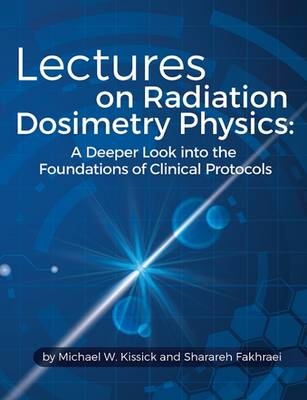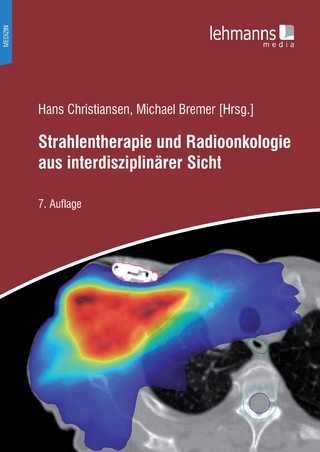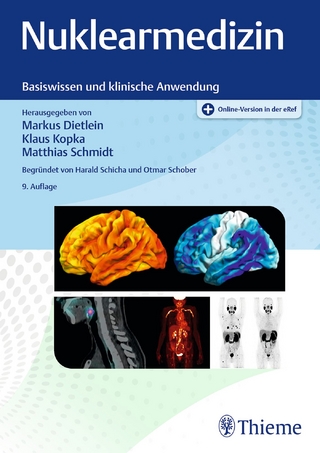
Lectures on Radiation Dosimetry Physics
Medical Physics Publishing Corporation (Verlag)
978-1-930524-92-7 (ISBN)
Modern protocols can guide a person toward uncertainties of only 0.5% in the energy deposited per unit mass, the dose. In order to achieve this remarkably low level of uncertainty, one must fully understand all of the subtleties along the way. That is the purpose of this book.
The aim of this work is to provide a deep understanding of all the pieces that underlie these practical protocols, and not to teach one how to use these protocols. It should be of interest to those who already have a basic education in this field, but who wish to expand and deepen their knowledge without all of the overhead of a large textbook. The information contained herein provides a more intuitive grasp of the physics concepts used in radiation dosimetry in medical applications, especially, but not limited to, radiation therapy physics.
1. Ionizing Radiation and What It Does in the Body
References
2. Radiation Fields and Their Statistics
Fluence and Fluence Rate
Energy Fluence and Energy Fluence Rate
Angular Distributions
Energy Distributions
References
3. Photon Interactions
Cross Sections and the Attenuation Coefficient
Terma, Kerma, and Collision Kerma
Dose Definition
Narrow and Broad Beam Geometry of Photons
References
4. Photoelectric Effect
Differential Cross Section for Photoelectric Effect (K-shell)
Fluorescent Photons and Auger Electrons
Mass Energy Transfer Coefficient for the Photoelectric Effect
References
5. Compton Scattering Effect
Differential Cross Section for Compton Effect
Differential Cross Section Relative to Recoil Electron Energy
Mass Energy Transfer Coefficient for the Compton Effect
Binding Energy Correction for the Klein-Nishina Cross Section
References
6. Pair (and Triplet) Production Effect
Pair Production
Cross Section for Pair Production
The Similarity between Pair Production and Bremsstrahlung
Triplet Production
The Triplet Production Cross Section
Positron Annihilation in Flight
References
7. Other Photon Interactions and Summary
Rayleigh (Coherent) Scattering
Photonuclear Interactions
Relative Importance of Each Interaction Type
Total Cross Sections (or Coefficients)
Cross Sections for Compounds and Mixtures
References
8. Charged Particle Interactions with Matter
Interactions of Heavy Charged Particles
Stopping Power and Mass Stopping Power
Collisional Mass Stopping Power for Heavy Charged Particles
Soft Collision Mass Stopping Power for Heavy Charged Particles
Hard Collision Mass Stopping Power for Heavy Charged Particles
Shell Correction
Dependence of the Stopping Power on the Medium
Mass Collisional Stopping Power Dependence on Particle Velocity
Mass Collisional Stopping Power Dependence on Particle Charge
Electron and Positron Interactions
Mass Collision Stopping Power for Electrons and Positrons
Polarization or Density Effect Correction
Restricted Mass Stopping Power
Linear Energy Transfer and Unrestricted Linear Energy Transfer
Mass Radiative Stopping Power
Radiation Length
Radiation Yield
Elastic Scattering
Multiple Scattering
Particle Range
Calculating the CSDA Range
Projected Range
Practical Range
References
9. Radiation Equilibrium
Fano's Theorem
Charged Particle Equilibrium
Exposure
Transient Charged Particle Equilibrium
References 85
10. Absorbed Dose in Media Containing Radioactive Materials
Radioactive Decay
Alpha Decay
Alpha Decay Specific to Dosimetry
Dose Rate Calculations for Alpha Decay
Beta Decay
Beta Decay Specific to Dosimetry
Fermi Theory of Beta Decay
Electron Capture (EC)
Dose Rate Calculations for Beta Decays and Electron Capture
Gamma Decay
Internal Conversion
Some Essential Gamma Decay Theory
Absorbed Fraction (AF)
Dose Rate Calculations for Gamma Decay and Internal Conversion
General Dose Rate Calculations
References
11. Dose from Directly Ionizing External Radiation Sources
Dose in Thin Films
1. Dose in Thin Films When d -ray CPE Exists
2. Dose in Thin Films When d-ray CPE Does Not Exist
Average Dose in Thick Foils
1. Average Dose in Very Thick Foils from Electrons
2. Average Dose in Thick Foils from Heavy Charged Particles
3. Average Dose in Thick Foils from Electrons
Dose When the Electron Energy Spectrum is Known
References
12. Dosimetry Introduction
Characteristics of Dosimeters
1. Precision or/vs. Accuracy
2. Dose Sensitivity
3. Stability
4. Energy Dependence
5. Angular Dependence
Ion Chamber Dosimetry
Cavity Theory
1. Bragg-Gray Cavity Theory
2. Spencer-Attix Cavity Theory
3. Other Cavity Theories for Photon Beams
Cavity Theory Examples and Discussion
Dosimetry Fundamentals
Advantages of Media Matching
References
13. Cavity Ionization Chambers, Circuits, and Corrections
Thimble-type Chambers
Condenser-type Chambers
Parallel Plate Chambers
Charge and Current Measurements
Charge Measurement Specifics
Current Measurement Specifics
Density and Humidity Corrections to an Ideal Ion Chamber
Ion Chamber Saturation and Recombination
References
14. Calibration of Ion Chambers and Photon Beams
Understanding TG-21 at the NIST Calibration Lab (ADCL)
Understanding TG-21 at the Clinic
Calibration of Electron Beams
Updated Calibration Protocol for Medical Photon Beams (TG-51)
A Few Key Concepts for TG-51 Calibration
References
| Erscheinungsdatum | 06.01.2017 |
|---|---|
| Verlagsort | Madison, WI |
| Sprache | englisch |
| Maße | 216 x 279 mm |
| Themenwelt | Medizin / Pharmazie ► Medizinische Fachgebiete ► Onkologie |
| Medizinische Fachgebiete ► Radiologie / Bildgebende Verfahren ► Nuklearmedizin | |
| Medizinische Fachgebiete ► Radiologie / Bildgebende Verfahren ► Radiologie | |
| Naturwissenschaften ► Physik / Astronomie ► Angewandte Physik | |
| ISBN-10 | 1-930524-92-7 / 1930524927 |
| ISBN-13 | 978-1-930524-92-7 / 9781930524927 |
| Zustand | Neuware |
| Haben Sie eine Frage zum Produkt? |
aus dem Bereich


